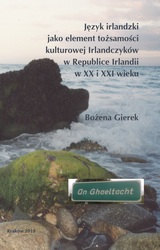
B. Gierek, The Irish language as an element of cultural identity of Irish people in the Republic of Ireland in the twentieth and twenty-first centuries [Język irlandzki jako element tożsamości kulturowej Irlandczyków w Republice Irlandii w XX i XXI wieku], Kraków 2018.
The main aim of the Author of the book, which consists of six chapters, was to identify the place of the Irish language in the lives of Irish people in the Republic of Ireland in the twentieth and twenty-first centuries. Determining the place of the Irish language in the lives of Irish people was connected with the definition of its place in their identity. At the beginning, it seemed obvious that this is a question of national identity. Yet, after a detailed analysis of a diverse range of materials, it turned out that it is cultural identity. The Author presents also a mechanism of transformation from national to cultural identity.
Contents
Introduction
1. Language-culture-identity
1.1. Origin and definition of language
1.2. Functions of language
1.2.1. Language and culture
1.3. Ecology of language
1.4. Usage of language skills in social interaction
1.5. Language as capital
1.6. Understanding of identity
1.6.1. Cultural identity
1.7. Language and identity
2. Historical-political context for the present situation of the Irish language
2.1. Colonial period
2.1.1. Education
2.1.2. Position of the Catholic Church on the language question
2.1.3. Revival of interest in the Irish language
2.1.4. The Irish language and political movements
2.2. Reasons for decline in the number of users of the Irish language
3. State language policy
3.1. The Irish language in the Constitution
3.2. Standardisation of the language and publication in the Irish language
3.3. Regulations regarding the Irish language on radio and television
3.3.1. Irish language radio and television
3.4. Regulations regarding the Irish language in education
3.5. The Gaeltacht
3.6. Commission on the Restoration of the Irish Language and White Paper
3.6.1. The White Paper in parliamentary debates
3.7. Bord na Gaeilge and Foras na Gaeilge
3.8. The Official Languages Act 2003
3.8.1. The Language Commissioner
3.9. State strategy
3.10. Other initiatives promoting the Irish language
3.11. The Irish language in the European Union
3.12. The fiasco of the state language policy
4. Education
4.1. History of education in Ireland
4.2. Education system in Ireland
4.3. Irish language in Irish education
4.4. Gaelscoileanna
5. Irish language in numbers – quantitative research
5.1. The 1970s
5.1.1. Irish language in the context of ethnical and cultural unity
5.1.2. Influence of education on the Irish language
5.1.3. Influence of home on the Irish language
5.1.4. Language competences
5.1.5. Irish language in interpersonal contacts
5.1.6. Irish language in cultural events and mass media
5.1.7. Vitality of the Irish language
5.1.8. Attitude to the Irish language in the context of the institutions
expected to promote it
5.1.9. Summary of the report of the Committee on Irish Language
Attitudes Research
5.2. The 1980s .
5.2.1. The results of research from 1983 compared with the results
of research from 1973
5.2.2. Irish language in education
5.2.2.1. Attitude of teachers to the Irish language
5.2.2.2. Attitude of parents to the Irish language
5.2.3. Research results from 1988/1989
5.3. The 1990s
5.3.1. Language competences and their usage
5.3.2. Perception of the Irish language
5.3.3. Irish language in education
5.3.4. Results of research conducted among employees of University
College Cork
5.4. The twenty-first century
5.4.1. Attitude towards the Irish language
5.4.2. Language competences and their usage
5.5. The Gaeltacht
5.5.1. Language differentiation in Corca Dhuibhne
5.5.2. Language differentiation in Múscraí
5.5.3. Reasons for language instability in the Gaeltacht and efforts to counteract it
5.6. Credibility of statistical data and their interpretation
5.6.1. Variety of interpretations
5.6.2. Usefulness of statistical data
6. Attitude of Irish people to the Irish language – qualitative research
6.1. Character of public discourse
6.2. Psychological consequences related to the loss of the Irish language and accompanying emotions
6.3. State language policy
6.4. Education
6.5. Irish language in the public sphere
6.5.1. The Gaeltacht
6.6. Market mechanisms – economy – modern trends
6.7. Pride or shame, defence or condemnation?
6.7.1. Around Reg Hindley’s book
6.7.1.1. Reg Hindley’s view of the Irish language case
6.7.1.2. Reaction to Reg Hindley’s book
6.8. The Gaeilgeoir
6.9. Increase of popularity of Irish language
6.9.1. Restoration of the identity of small communities as a result of voluntary actions
6.10. Language as an essential element of national identity
6.11. Language and culture
6.11.1. Seachtain na Gaeilge and Oireachtas
6.11.2. Writing in the Irish language
6.11.2.1. Impenetrability of the language
6.11.2.2. Why write in the Irish language?
6.11.2.3. Hybridity
6.12. The Irish language in the context of immigration to Ireland
6.13. Looking into the future
Conclusions
Appendix. Examples of Irish language use in the public sphere
List of photographs and other materials in the Appendix
Bibliography
Contents
Summary
Index of Irish terms

